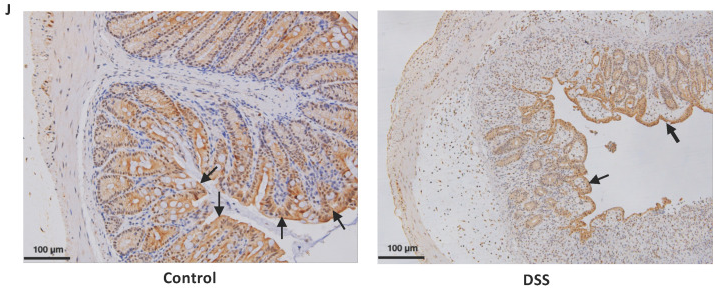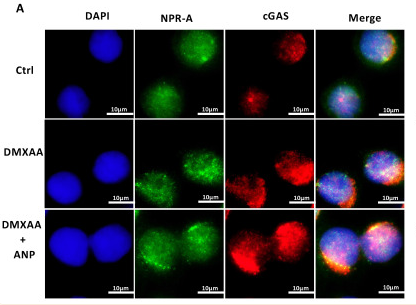NPR1 Antibody - #DF10132
| Product: | NPR1 Antibody |
| Catalog: | DF10132 |
| Description: | Rabbit polyclonal antibody to NPR1 |
| Application: | WB IHC IF/ICC |
| Cited expt.: | WB, IHC, IF/ICC |
| Reactivity: | Human, Mouse, Rat |
| Prediction: | Pig, Bovine, Sheep, Rabbit, Dog |
| Mol.Wt.: | 119 kDa; 119kD(Calculated). |
| Uniprot: | P16066 |
| RRID: | AB_2840712 |
Related Downloads
Protocols
Product Info
*The optimal dilutions should be determined by the end user. For optimal experimental results, antibody reuse is not recommended.
*Tips:
WB: For western blot detection of denatured protein samples. IHC: For immunohistochemical detection of paraffin sections (IHC-p) or frozen sections (IHC-f) of tissue samples. IF/ICC: For immunofluorescence detection of cell samples. ELISA(peptide): For ELISA detection of antigenic peptide.
Cite Format: Affinity Biosciences Cat# DF10132, RRID:AB_2840712.
Fold/Unfold
ANP-A; ANPa; ANPR-A; ANPRA; ANPRA_HUMAN; Atrial natriuretic peptide A type receptor; Atrial natriuretic peptide receptor 1; Atrial natriuretic peptide receptor A; Atrial natriuretic peptide receptor type A; Atrionatriuretic peptide receptor A; GC A; GC-A; Guanylate cyclase A; Guanylate cyclase; GUC2A; GUCY2A; Natriuretic peptide A type receptor; Natriuretic peptide receptor A/guanylate cyclase A; NPR-A; NPR1; NPRA;
Immunogens
A synthesized peptide derived from human NPR1, corresponding to a region within the internal amino acids.
- P16066 ANPRA_HUMAN:
- Protein BLAST With
- NCBI/
- ExPASy/
- Uniprot
MPGPRRPAGSRLRLLLLLLLPPLLLLLRGSHAGNLTVAVVLPLANTSYPWSWARVGPAVELALAQVKARPDLLPGWTVRTVLGSSENALGVCSDTAAPLAAVDLKWEHNPAVFLGPGCVYAAAPVGRFTAHWRVPLLTAGAPALGFGVKDEYALTTRAGPSYAKLGDFVAALHRRLGWERQALMLYAYRPGDEEHCFFLVEGLFMRVRDRLNITVDHLEFAEDDLSHYTRLLRTMPRKGRVIYICSSPDAFRTLMLLALEAGLCGEDYVFFHLDIFGQSLQGGQGPAPRRPWERGDGQDVSARQAFQAAKIITYKDPDNPEYLEFLKQLKHLAYEQFNFTMEDGLVNTIPASFHDGLLLYIQAVTETLAHGGTVTDGENITQRMWNRSFQGVTGYLKIDSSGDRETDFSLWDMDPENGAFRVVLNYNGTSQELVAVSGRKLNWPLGYPPPDIPKCGFDNEDPACNQDHLSTLEVLALVGSLSLLGILIVSFFIYRKMQLEKELASELWRVRWEDVEPSSLERHLRSAGSRLTLSGRGSNYGSLLTTEGQFQVFAKTAYYKGNLVAVKRVNRKRIELTRKVLFELKHMRDVQNEHLTRFVGACTDPPNICILTEYCPRGSLQDILENESITLDWMFRYSLTNDIVKGMLFLHNGAICSHGNLKSSNCVVDGRFVLKITDYGLESFRDLDPEQGHTVYAKKLWTAPELLRMASPPVRGSQAGDVYSFGIILQEIALRSGVFHVEGLDLSPKEIIERVTRGEQPPFRPSLALQSHLEELGLLMQRCWAEDPQERPPFQQIRLTLRKFNRENSSNILDNLLSRMEQYANNLEELVEERTQAYLEEKRKAEALLYQILPHSVAEQLKRGETVQAEAFDSVTIYFSDIVGFTALSAESTPMQVVTLLNDLYTCFDAVIDNFDVYKVETIGDAYMVVSGLPVRNGRLHACEVARMALALLDAVRSFRIRHRPQEQLRLRIGIHTGPVCAGVVGLKMPRYCLFGDTVNTASRMESNGEALKIHLSSETKAVLEEFGGFELELRGDVEMKGKGKVRTYWLLGERGSSTRG
Predictions
Score>80(red) has high confidence and is suggested to be used for WB detection. *The prediction model is mainly based on the alignment of immunogen sequences, the results are for reference only, not as the basis of quality assurance.
High(score>80) Medium(80>score>50) Low(score<50) No confidence
Research Backgrounds
Receptor for the atrial natriuretic peptide NPPA/ANP and the brain natriuretic peptide NPPB/BNP which are potent vasoactive hormones playing a key role in cardiovascular homeostasis. Has guanylate cyclase activity upon binding of the ligand.
Phosphorylation of the protein kinase-like domain is required for full activation by ANP.
Membrane>Single-pass type I membrane protein.
Belongs to the adenylyl cyclase class-4/guanylyl cyclase family.
Research Fields
· Environmental Information Processing > Signal transduction > cGMP-PKG signaling pathway. (View pathway)
· Environmental Information Processing > Signal transduction > cAMP signaling pathway. (View pathway)
· Metabolism > Nucleotide metabolism > Purine metabolism.
· Organismal Systems > Circulatory system > Vascular smooth muscle contraction. (View pathway)
· Organismal Systems > Endocrine system > Oxytocin signaling pathway.
· Organismal Systems > Endocrine system > Regulation of lipolysis in adipocytes.
· Organismal Systems > Endocrine system > Renin secretion.
· Organismal Systems > Endocrine system > Aldosterone synthesis and secretion.
References
Application: IHC Species: Mouse Sample: murine colonic tissue
Application: WB Species: Human Sample: HT-29 cells
Application: IF/ICC Species: Human Sample: HT-29 cells
Restrictive clause
Affinity Biosciences tests all products strictly. Citations are provided as a resource for additional applications that have not been validated by Affinity Biosciences. Please choose the appropriate format for each application and consult Materials and Methods sections for additional details about the use of any product in these publications.
For Research Use Only.
Not for use in diagnostic or therapeutic procedures. Not for resale. Not for distribution without written consent. Affinity Biosciences will not be held responsible for patent infringement or other violations that may occur with the use of our products. Affinity Biosciences, Affinity Biosciences Logo and all other trademarks are the property of Affinity Biosciences LTD.



